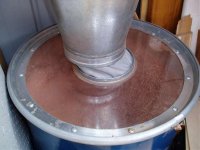I thought I'd just drop in and say Hi to everyone and introduce myself, I live in Melbourne, Australia and do woodworking as a hobby. I’ve had my cyclone for almost two years and built it from plans, which I downloaded from Bill Pentz’s site. I have to say that I really enjoyed building the cyclone and ductwork and am very happy with it.
I have seen some very impressive cyclone setups in people’s workshops that have posted, some really great ideas, thanks.
I am no expert when it comes to cyclones but am only to happy to share what I know and get great pleasure in learning new techniques and generally talking 'shop'.
Thank you for letting me join your community.
Regards,
Al
I have seen some very impressive cyclone setups in people’s workshops that have posted, some really great ideas, thanks.
I am no expert when it comes to cyclones but am only to happy to share what I know and get great pleasure in learning new techniques and generally talking 'shop'.
Thank you for letting me join your community.
Regards,
Al

